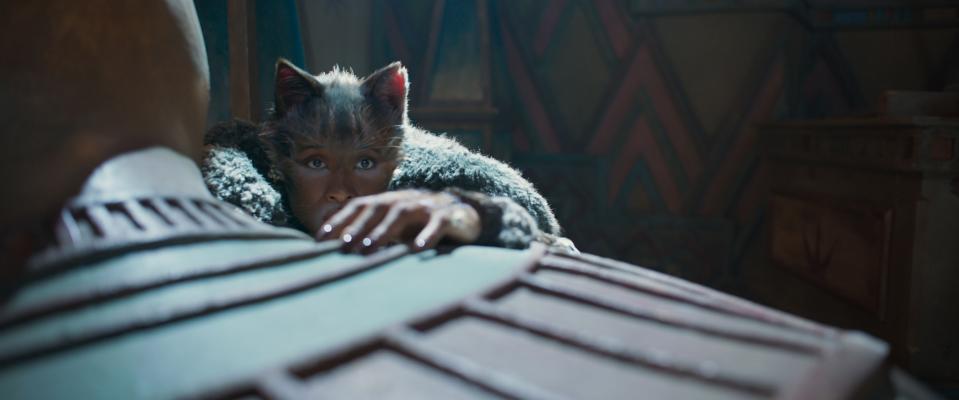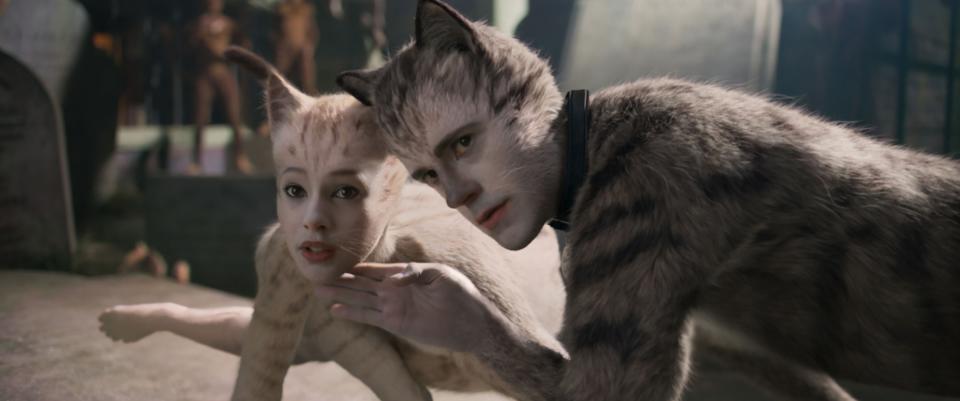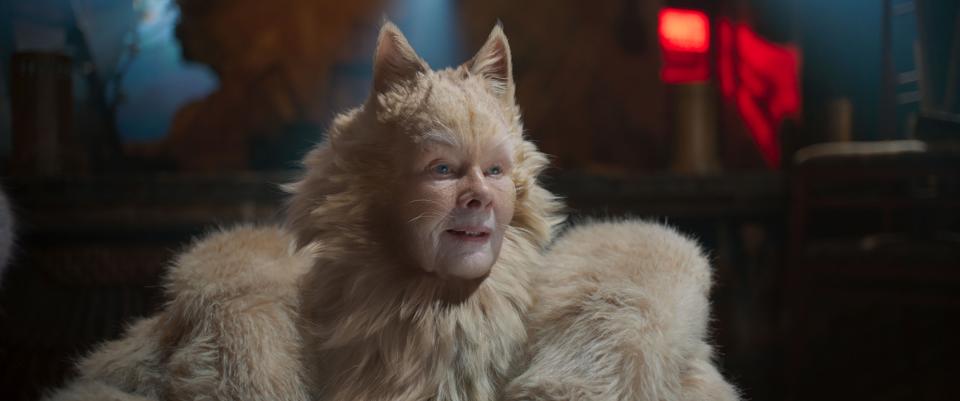Extraordinary People Doing Extraordinary Things: Behind the Scenes of Cats
When Andrew Lloyd Webber’s musical Cats opened in London’s West End in 1981, one of the earliest audience members was an 8-year-old Tom Hooper. He remembers “being utterly entranced and captivated and blown away” by the piece, which is based on T.S. Eliot’s Old Possum’s Book of Practical Cats, a collection of poems, published in 1939, that Eliot had originally written for his godchildren.
Staged at the time by director Trevor Nunn and designed by John Napier to evoke a Victorian junkyard, with the performers in furry leg warmers and punkish Frisbee Fox hair, the much-beloved musical went on to run for 21 years and nearly 9,000 performances in the West End and for 18 years on Broadway. “I persuaded my parents to buy the cassette, and listened to the music until it was worn out,” Hooper remembers. “If you had told me then that one day I would direct the movie, I would have been completely bamboozled. And to have done this hand in hand with Andrew Lloyd Webber has made it even more exciting—it’s an extraordinary example of ‘You never know what the future might hold for you!’”
The project had its genesis seven years ago when Hooper was just finishing his Academy Award–winning adaptation of Les Misérables. “I’d learned so much about the form of musicals from that, and was thinking about what else had not been made into a film,” he recalls. “And I immediately thought of Cats.” Hooper knew that Steven Spielberg had once optioned it. “I wondered if he’d been daunted,” he tells me, “but the march of technology has opened a portal into the way we can make it possible. Only as recently as three years ago I was told that what I wanted to do—tracking fur onto faces and bodies—was not technically possible. Two years ago, it was technically possible but financially impossible, and a year ago it was technically possible and just about financially possible . . . so we are on the edge of the curve. It’s very exciting.”
Taylor Swift was Hooper’s first call. She responded to his vision for the piece and ended up not only playing the sultry showgirl Bombalurina, but also writing the lyrics for “Beautiful Ghosts,” a new song that Lloyd Webber has written for the story, its narrative newly shaped by Hooper and screenwriter Lee Hall. Onscreen, this is sung by the exquisite Francesca Hayward, moonlighting from her role as a principal dancer with the Royal Ballet in her film debut as Victoria, an abandoned beauty whose empathy reaches beyond the Jellicle pack mentality. Hayward, as she recalls, heard the song “for the first time with Taylor Swift singing it to me in a very personal private concert. I’ll never forget that at the end of it, she asked me if that would work for me—I was so stunned, I think I went very British and sarcastic and said, ‘Yes, that will be okay!’”
Despite the use of technology, Hooper insisted, as he did in Les Misérables, on live performances from his starry cast—something he describes as “capturing lightning in a bottle. I didn’t want to have extraordinary people doing extraordinary things and lose them to some postproduction technology.” Hooper avers that the production is rooted in his childhood memories. “I am directing it for my 8-year-old self,” he says. All the sets and props were scaled to cat proportions—roughly two and half times larger than life. “I don’t care how old you are,” says Jennifer Hudson, the movie’s electrifying Grizabella, “seeing everything so magnified, we all turned back into children. It was cool really being able to see from a cat’s perspective.”

MCDCATS UV006
Earlier this year I went on set in the film’s vast studios in the Hertfordshire countryside and experienced the magic for myself. Hooper and his production designer, Eve Stewart (the costumes are by Paco Delgado), have set the story on the eve of World War II, when Eliot originally wrote his poems. “I always saw it as a love letter to London, and more specifically to Soho,” says Hooper. “I wanted the strong patina of London, and the late 1930s is a period I was very familiar with from The King’s Speech—although it is a fantastical reimagining of a period London.”
It is as if one’s toddler self was wandering through the streets and alleys of a timeworn Soho, stylishly and playfully evoked with spongy cobblestones to help the dancers spring in catlike bounds. A back alley is crowded with Brobdingnagian trash cans among which James Corden will cavort, while the giant back door includes a human-scale cat flap through which Jason Derulo will lead a pack of alley cats to the glamorous Milk Bar, an Art Deco symphony in turquoise and silver. An ogre’s van from Catford Dairy contains old-fashioned milk bottles the size of Mathusalem Champagne bottles. Maple leaves like dinner plates have blown up against the high tread of the sidewalks, and bicycles and perambulators are too tall to climb onto or into.
Another echoing aircraft hangar is home to a set representing a perfect Depression-era kitchen, where Rebel Wilson’s droll, slothful Jennyanydots will lounge her days away. The flour and sugar tins look as though they could feed an army, and even the print on the cretonne curtains and the nasturtium embroidery on the linen cushion is overscaled. It is a touching flashback to infancy, to a barely remembered moment of looking up at the faraway seat of a kitchen chair and a tabletop that are too high to climb on without gymnastic exertions—they even presented a challenge for the limber Hayward.

MCDCATS UV001
“The most exciting thing is to discover people’s capacity to be talented in areas they are not trained in or known in,” says Hooper. “If I hadn’t asked them to audition, they might not even have known they have these skills.” Idris Elba, who plays Macavity,“ was thrilled to be singing and dancing with Taylor Swift,” and Hayward reveals herself to be an instinctive onscreen actress, with a voice as elegant and delicate as her persona. The dancer admits to being a bit nervous about the prospect of singing. “I mean, I dance the Rose Adagio in Sleeping Beauty and balance on one leg [on the toe of a pointe shoe, no less], but I am much more relaxed about that than I was about performing in front of the film’s casting director,” Hayward says. “I’m so happy that I ventured out beyond the Royal Ballet—which is my home, and I love it—but I would never have pushed myself outside of my comfort zone. Now I can’t imagine my life without this.”
On yet another set sits a doughty Victorian tugboat, the deck raked at an alarming angle, as if bracing against an unexpected swell. The only thing is that the deck is as broad as one of the menacing cruise ships looming over Venice, and the ship’s rope is as thick as Elba’s thighs—and wait, Elba himself is prowling the deck in a platinum Lycra onesie and a fake fur coat that costume designer Delgado has slashed and scratched to suggest a fight-seasoned alley cat. Other cast members assembled on this improbably starry deck include Swift, Sir Ian McKellen, Wilson, Corden, Ray Winstone, and Dame Judi Dench, who is dressed in a raggedy trained fur worn slouched off one shoulder that makes her look like a gangster Dietrich. (“Gangster Dietrich? I rather like that,” she purred. “I’m going to use that.”) Lloyd Webber’s original production was to have featured her in the role of Grizabella. Dench, however, broke her ankle a week before curtain, so Elaine Paige stepped in and, in time-honored fashion, became a star, making an enduring hit of the elegiac featured song, “Memory.”
“In a story of new lives and regenerations,” says Hooper, “40 years later, Dame Judi has got to be in Cats!” Onscreen, Dench (now as Old Deuteronomy, who must decide which cat is worthy of a second life) and McKellen (as Gus the Theater Cat) give master classes in scene stealing. Ears twitching, whiskers bristling, it is their eyes and mouths that tell the story, signaling empathy, pathos, terror, mischief, insight, and practically every other human experience by turns. It is a joy to watch them both.

MCDCATS UV008
Though Hudson drew inspiration from her own cats, Macavity and Grizella—“You never see them broken—they are very independent and strong,” she says—all of the performers have taken seminars in feline behavior: “cat school” from Sarah Dowling, whom everyone refers to as the Cat Lady. As a result, Hayward carries her shoulders in an inverted boomerang arch, for instance, and nuzzles the hapless but irresistible magician Laurie Davidson (Mr. Mistoffeles) cheek to furry cheek. Davidson, in the company of Hayward and Fairchild and the astonishing dance ensemble choreographed by Andy Blankenbuehler (a Tony winner for Hamilton), practiced at the barre every morning to improve his own ballet game. Hayward had to be on set at 6:30 every morning for full ballet training—directly after filming, she was headed into rehearsals for the lead in the Royal Ballet’s Romeo and Juliet. (“I never thought I’d be doing ballet class in the dark!” she says.)
In addition to their bodysuits, most of the dancers are also wearing headpieces, which digitally track their movements so that their cat features—moving ears, moving tails, whiskers—can be added on later. Still, all the actors’ faces are still recognizable. Hooper describes the process as “making them into cats while protecting their humanity.” Onscreen, it takes a few minutes to surrender to the concept, and then the performances and the ravishing visuals—and, of course, Lloyd Webber’s music and Eliot’s words—sweep one away on Thames tides of nostalgia.
Hayward, who is 27, had never seen the stage version of Cats but watched the video as a child as a respite from looking at ballet. For Hudson, however, Cats “wasn’t something I grew up with—I had never seen the play, but I was more familiar with the songs, so my connection was through music. Grizabella has been an outcast,” says Hudson of her character, a former glamour girl brought low by the evil machinations of Macavity. “Each cat has her chance, and she sings her heart out to have that chance—she sings about her heart and her pain; she’s very vulnerable and broken. You wonder for her, you want to know her story—you feel for her.”
“Jennifer is such a gifted dream person,” says Hooper. “Her voice has such emotion that when she sings ‘Memory’ she makes people cry.” The process, as Hudson recalls, was physically exhausting. “I sang “Memory” 35 or 36 times, for two days straight,” she says. “At one point—because it’s so emotional—I fell asleep between takes, only to wake up seeing Tom standing over me—and I just started singing it again!” Hudson’s astonishingly powerful rendition, made more potent still by her own unimaginable personal tragedies, is a heartbreaking showstopper.
“It was amazing to be in such great company,” says Hudson. “I’m still in awe of it—the diversity in the talent level, the great dancers, the world’s greatest actors. Everybody’s at the top of their game. This is one project that incorporates every form of art you can imagine—music, poetry, dance. I remember being on set and telling Tom Hooper: ‘Now this is real movie magic—I feel that it will become part of people’s lives and their holiday traditions.’”
Originally Appeared on Vogue

